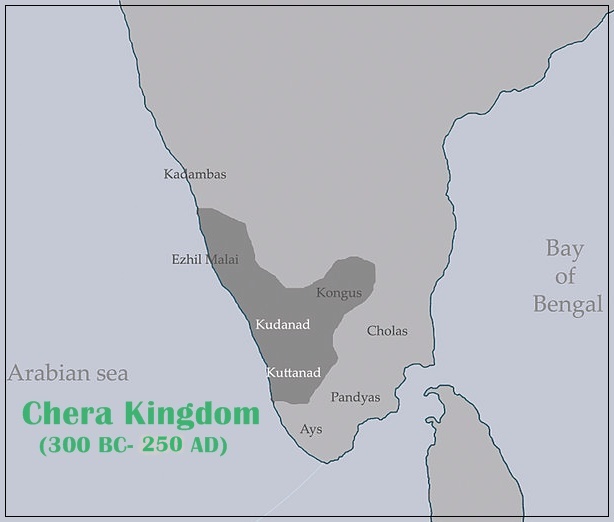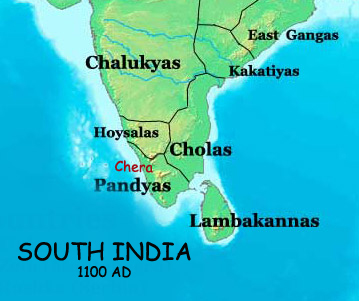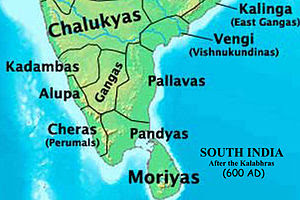-
Chapter 9: SANGAM - AGE
Introduction
South of the Deccan plateau, the land between the Venkatam hills and Kanyakumari is known as the Tamilaham. The sangam texts mention three chiefs the Chola, Chera and Pandya. each of them had two strongholds both in the interior as well as on the coast.
Sangams provide a account of the society and polity of those times. There were three successive assemblies of Sangams and the work of the last sangam has survived. Sangams were held in the town of Madurai. At the sangams eminent scholars assembled and functioned as the board of censors and the choicest literature was rendered in the nature of anthologies. These literary works were the earliest specimens of Dravidian literature.
The heroic poems and other works of the Tamil literature are testimony to the prevalent literary culture of the early Tamilian people. It is also a sign of the early maturity of the Tamil culture and language.
Sangam age tells us about the literary and societal state of the sangam society. It also tells us about the economy and society but diesnt give sufficient information about the political life and political establishments.
The Society - Sangam Age
Sangam literature tells us that the Tamilaham represents a combination of diverse ecological zones which comprised of hilly regions, river valleys, coastal areas and grasslands etc. Each had its own level of production, social division of labor and lifestyle. However there was an interaction and interdependence between different ecozones which led to development of larger ecozones.
The land were controlled by chiefs and among them the chiefs of the Cholas, Cheras and Pandyas were regarded as kings because they controlled the agrarian lands and river valleys which had coastal ports which were becoming popular because of lucrative trade.
The cultivators were required to pay taxes and this was collected through them by use of force. However, the taxation system isnt known and information is insufficient. The regular system of taxation wasnt known. The major concern of these groups was war and bringing the independent chiefs under their subjugation. War was celebrated as a noble heroic act and was institutionalized. War heroes and martyrs were celebrated as noble heroic acts.
The continuos wars had a havoc on the lives of poor peasants. The fields were looted and cattle slain or captured. The peasant was defenceless in these wars. Agriculture was the main occupation and other rudimentary occupation was crafts. Artisans like blacksmiths and weavers were known and mentioned in the literature.
The character of the society is tribal with tribal rituals and customs. But as the society became agriculture based, a complex caste system like the brahmanical varna system emerged. Buddhism too was taking roots in this society.
Thus, the tamil society as mentioned in the sangam period ranged from simple chiefdom of clans to complex chiefdoms of ruling houses. A full fledged state organization was yet to take shape.
The society was composed of unevenly developed components that shared a common culture.
The Deccan and South
Sangam period drew to a close in about the end of the 3rd Century. The history for the next 300 years is obscure. The early history of the Pallavas belongs to this period. The Pallava rule was effectively in Kanchi region however a mountaineous tribe named Kalabhra pushed them from this land to the north. The Kalabhras put an end to the rule of chola, chera and pandyas during the sangam period. They were against brahmanical institutions but favored buddhism and jainism. Their threat extende till the Chalukya kingdom in North Karnataka.
The Kalabhra period ended and the region was now involved in a triangular conflict between the Chalukyas of Badami, Pandyas of Madurai and the Pallavas of Kanchipuram. The Pallavas had conquered the eastern part of the Satvahana empire which was the delta between krishna and godavari. The Chalukya had established their kingdom on the ruins of Vakatakas in western deccan. The Vakatakas had previously setup their empire on the ruins of the Satavahanas.
Pallavas defeated the Kalabhras in Kanchi and extended their empire to the borders of chalukya. Pandyas also defeated Kalabhras in Madurai. However, the city of Vengi lying between Godavari and Krishna was a major cause of conflict between Chalukyas and Pallavas. Pandyas were weak and would join the conflict occasionally.
The relationship between the Pallavas and Cheras who dwelt in the coastal strip of Malabar was however amicable.
Chalukya were able to defeat the King Harshavardhan at river Narmada and prevent his advance in the south. They also defeated Pallavas for a short while by capturing Vengi. However, the Pallavas soon attacked Vatapi, the chalukya capital and conquered it. Both the Pallavas and the chalukyas were evenly matched and couldnt defeat each other.
chalukyan kingdom in the western deccan saw conflict with the arabs. However, their feudatories Rashtrakutas declared independence and soon captured and destroyed the chalukya dynasty. Pallavas survived for a century more but they also came into attack by the Pandyas and their feudatories cholas. Cholas defeated and captured the pallava kingdom and the pallavas survived for a short while as the feudatories of the Cholas before fading out.
Chalukyas ere known for granting asylum to the zoroastrians who had fled from persia to escape forcible conversion by the arab invaders. The descendants of these zoroastrians are the parsi community.
Art and Architecture - South Indian Kingdoms
Chalukya kings gave a large sum for building of temples and cave shrines in the deccan hills. The jain temples at Mt Abu, buddhist shrines at Ajanta and the hindu and buddhist temples at Ellora are the most impressive of these. Rock cut temples at Elephanta island are also attributed to the chalukyas. Rashtrakutas are credited with construction of the Kailasnath temple at Ellora, a rock cut structure made out a single large rock.
South Indian Kingdoms - Economy
This period saw the extension of land under cultivation and settlements through land grants to brahmanas which was exempt from various taxes and dues. Most of these lands were virign forests but grants were also made for regions which were already under cultivation. The ruling families derived economic advantage as when such lands were brought under cultivation it would lead to increase in resource base.
Grants ensured that the rulers received support from the brahmins. The religious texts also sanctioned such grants. This was to ensure that the brahmans received their subsistence. Land grants were also given to non brahmin religious establishments such as buddhists and jain temples.
Land gifts to officials also became prominent during the Gupta and the Post Gupta period. Land grants led to new class of land owners emerging. Kings who had been defeated continued to rule over their lands after accepting the suzerainty of the new powers. This meant that the king would become a vassal and send tribute to the new lord by sharing revenue from the land.
The reach of water resources was an important consideration in the spread of rural areas. There was increase in canals, lakes, wells and irrigation facilities like tanks. These were referred using different names like Keres (tanks, Nadi (river), Araghatta (wells), Srota (water channel) and Vapis (step wells). Land grants paved the way for emergence of a feudal system in India.
Agrarian economy - sangam age
Emergence of hierarchical landed intermediaries who were vassals, intermediaries, officers of state, secular assignees and had military titles or feudal titles. These intermediaries increased the distance between the producer and the king. The administrative structure also became like lord vassal relationship.
Due to the greater claims for rights over land by the intermediaries, peasants suffered a loss of the land rights and became tenants at will. They were also required to be slaves or forced labors of these new land lords. Earlier this authority would be only with the king but now it was given to the numerous intermediaries. Surplus was extracted by various measures and actual quantity left with the tillers was pretty less.
A closed economy was created in the village between the villagers and the artisans who remained attached to the village. Each supported the others needs and goods were exchanged on barter. The shortage of coins and other mediums of exchange further strengthened this system.
Agriculture continued to be the chief of the occupations practiced. The cultivation of many crops and cash crops is recorded. Trade of high valued goods continued but due to shortage of coins barter system was prevalent for daily use goods. The irrigation technology also improved and many implements were used for agriculture. Thus there was an advancement in agriculture and irrigation and this led to unprecedented increase in production.
The Sangam age was a glorious period for south
India.
The Sangam is an Academy of Poets and great
literary work emerges out of them. The Sangam flourished under
the patronage of the Pandya’s dynasty.
The probable dates of Sangam era were decided as 3rd
century BC – 3rd Century AD.
Chronology of Sangams
First Sangam – Madurai – Attended by gods
and legendary sages but no work survived.
Second Sangam – Kapadapuram – Tolkappiyyam
is the only literary work that survived.
Third Sangam – Madurai – Few literary works
survived.
The political situation during the Sangam is known:
The south India was ruled by Chola, Chera and Pandya during this
time.
Each of them had two power centres one inland
and one on the coast.
Sangam Dynastys
Chera dynasty: Royal emblem: Bow
- They ruled over modern Kerala.
- Castes not known.
- No superstitions. Ancestors and tree worship seen.
- Declined as trade with Romans declined.

Fig 1: Chera kingdom
Chola dynasty: Royal emblem: Tiger
- They ruled over southern Andhra Pradesh and part of north Tamil Nadu.
Pandya dynasty: Royal emblem: Carp
- They ruled over Tamil country.
- Hereditary monarchy with king assisted by council of ministers. There was a large body of officials for administration.
- Empire divided into mandalam ->nadu -> urs.
- Rulers kept a regular army.
- Land revenue was main income source. Customs duty and war booty were others.
- Trade was prosperous. Pearls were famous.
- Sati, castes, idol worship were common. Widows were treated badly.
- Temples had:
· Gopuram
· Garbagriha
· Viman
· Prakaras
·
Gateways.
Apart from these three there were minor chieftains who were subordinate to the Chera, Chola and Pandya but were strong and powerful in their respective regions.


Fig 3:
South Indian kingdoms
Sangam Polity:
Hereditary monarchy was prevalent. But king
had advisors to assist him.
Each ruler had a regular army.
Land revenue was the chief source of income and customs duty was imposed on foreign trade. War booty was also a source of income. Roads and highways were protected from thieves.
Murugan was the chief god. Even deceased who had died in wars were worshipped.
Caste system was known. Women had respect and allowed to pursue intellectual pursuits. But condition of widows was bad. Sati was prevalent. But women were allowed to choose their partners.
Art, music and dancing were popular in Sangam age. Highly developed forms of music and dance were known.
Trade and agriculture flourished in this period. Internal trade was on barter system. External trade was carried with Greek civilisation using naval vessels.
Agriculture was the main occupation. Handicrafts, metal works and garments were famous in internal and external trade. Roman Empire too traded with them and roman merchants were present in Tamil country. Gold and silver roman coins are found here.